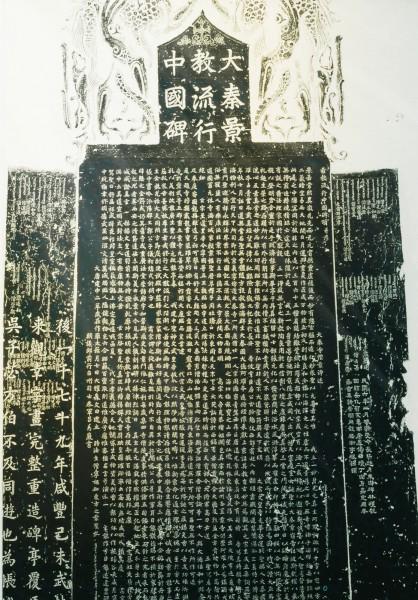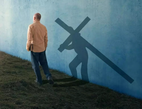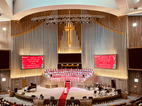The story begins with a piece from the collection of my 86-year-old Canadian-British godmother Beth Leach's - an original rubbing piece bought by her father, Albert Lutley, a stele or stone slab displaying the original Chinese script with the meaning, "Nestorians' Prevalence in China".
I love paintings and my recent love is stone carving wax painting. My godmother talking of having a stone carved art rubbing piece, namely this one, shocked me. The original piece was bought by her father in China during World War II. This stele or monument had been ranked the first among the world's four most famous monuments. It is also most indispensable and important proof for witnessing to and studying about ancient Christianity.
I have long heard of the "Nestorian Stele ". It is 279 cm high and 99 cm wide containing a total of 1780 Chinese characters as well as Assyrian script. The top of the monument is engraved with lotuses and a cross. The stele was originally standing in the Daqin Temple in Chang'an City of the Tang Dynasty (618 A.D. - 907 A.D.). As to when it was buried is unknown, but it is the oldest image that witnesses to Christianity's existance in China.
Knowing that my godmother has the rubbing piece of the monument which is half a century old, I immediately asked the Director of the Dunhuang Institute, Zhao Shengliang, about the stele. The old friend promptly sent many books about Dunhuang with a fairly large amount of information on the history of Nestorianism in Dunhuang. "The Nestorian Stele" has a 1300-year history of being exposed to the elements. What happened after the Tang Dynasty? In Zhao's book, it is affirmed that from the Tang to the Yuan Dynasty (1271 A.D. - 1368 A.D.), there truly were Nestorians in Dunhuang.
The ancient Persian missionary Alopen trekked to the then capital of Chang'an. "Daqin" was the name for "Rome" during the Han and Tang Dynasty. The inscription's content is concise. There are stories of the fall of mankind, the birth of the Messiah, and the story of the Savior.
My godmother particularly acknowledges and values her rubbing piece: "God knows everything! He gives us minds to take in knowledge, but leaves us the choice of what we will take into our minds." Talking to my godmother again, she said that her father Albert Lutley, grieving at having just lost his beloved son, was willing to pay for the rubbing paper as if it was the "Bible" of his life.
It can be imagined people suffered greatly in World War II. When a poor country had no money to protect its homeless people, some people then suggested that because the "Nestorian Stele" wasinternationally famous, rubbings should be made to then sell. Experts could use ancient methods of printing with ink and paper to rub and print five hundred copies of the inscriptions. At that time of turmoil each piece could be sold for at least a hundred dollars. This huge income seemed to have proved that the stone monument is like the power of God--more people could be saved and reborn, and even help the poor China to continue to resist the Japanese.
I was just as moved the last time I saw Beth's old "Bible" which is three centuries old. It was her grandfather Lu Yiquan's working reference Bible when he was selected by Hudson Taylor as one of the 100 missionaries to China. It was then passed on to Albert Lutley and finally to Beth Leach. From Beth's description of the rubbing piece, it can be imagined that for thousands of years, the stone monument has gone through water and fire, and even had been abandoned in the wilderness for about two hundred years.
Can it be said that without Emporer Tang Taizong there would be no Christianity today? In 635 A.D., the Tang Dynasty under Tang Taizong's administration was at its strongest. The most powerful religion then in China was Buddhism, but the emperor also granted the newly introduced Christian mission to spread the Gospel in China. He sent the Prime Minister, Fang Xuanling to the western suburbs of Chang'an to welcome the Nestorians as a national delegation. In addition to the Prime Minister, General Guo Ziyi was also a Christian. Tang Taizong Emperor listened to Aroben's sermon and approved his preaching. Nestorianism once flourished in Chang'an. The entire country built "cross temples" (i.e. churches), while allowing translation of the Bible. Christianity in the Tang Dynasty was recorded with the inscription: "In each state is built a Nestorian temple. Its law flows in ten ways; its temples are full of a hundred cities". No wonder Nestorianism was popular for about 200 years. Must there have even been some who celebrated Christmas in the Tang Dynasty?
When Tang Wuzong Emperor destroyed Buddhism, Christianity also suffered, and the monument had been buried until it was unearthed in 1623. In 1907 it was moved to Room #2 of the Xi'an Stone Forest Museum.
I always love drawing. My godmother sent me this message: "He loves beauty, and gives us different abilities to create beautiful things. We too can make things beautiful as you do! Keep reading the New Testament to get to know the Author more and more! "
- Translated by Charlie Li












